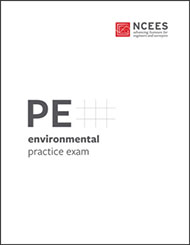NCEES PE Environmental Engineering Practice Exam, Print
Backordered Until 6/11
Contains the same great questions published in previous versions of this book along with exam specifications effective in 2019 when the exam becomes computer-based.
This official NCEES publication contains 80 sample problems and solutions to help you familiarize yourself with the Environmental PE exam format and content.
This book contains 80 questions and solutions to familiarize you with the PE Environmental exam format and content.
FAQs
Some states require a BS degree from an ABET-accredited engineering program to sit for the PE exam. Other states allow you to take the PE exam with a degree in engineering technology, physics, math, or chemistry—or without any degree—as long as you’ve met the required work experience. Check your state requirements to see if you can take the PE exam without an engineering degree.
Most states allow you to take the PE exam after passing your FE exam and gaining at least four years of post-college work experience. However, some states now allow examinees to sit for the PE exam before completing their work experience. Check your state requirements to see when you’re qualified to sit for the exam.
The PE exams are not considered easy to pass, but the exam will become easier if the content reflects topics that you're familiar with from your current line of work. Think about your career goals when considering the PE exam. Are you seeking a promotion in your current role? You should select the exam that best supports your current career. Are you trying to switch industries? Choose the exam that will set you up for success in your new field. Rather than seek out the easiest PE exam, select the one that will support your goals.
